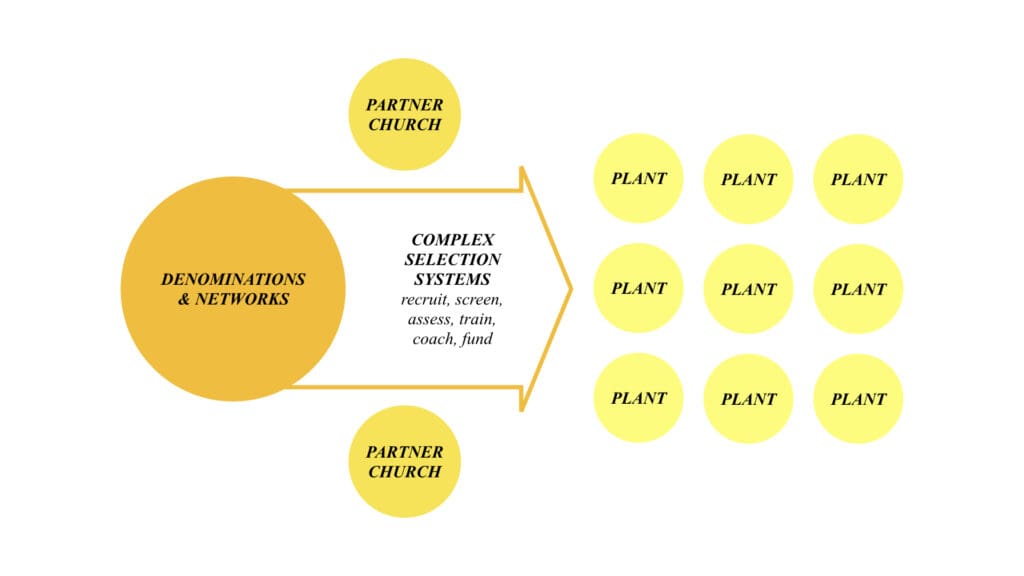Whether it’s called multiplying, parenting, sending, sponsoring, or partnering–churches that plant churches and even networks of churches are becoming the new normal conversation in church planting.
A little over a decade ago, the paradigm for church planting in North America began shifting from addition to multiplication, meaning that instead of just planting churches, leaders and organizations seriously began focusing their vision and strategy on planting churches that plant churches. It was around that time that a leading church planting conference in North America with a very intentional name sprung up, Exponential. Books like The Multiplying Church and Viral Churches began challenging us towards a new metric not defined by being the largest church in the city, but instead by being a part of a movement that was “churching” the city. The Church Multiplication Network came into existence from the Assemblies of God, Redeemer became City to City taking their work globally, and other networks, like Acts 29, renewed their focus on being a network of church planting churches.
The shift towards multiplication began happening after the time when organizational systems like recruitment, screening, assessment, training, coaching, and funding were getting firmly into place–at least for some networks and denominations. These systems were adapted from the ones used by foreign mission boards. By 1987, Dr. Thomas Graham had already been writing about the implementation of systems and assessment centers for Mission North America (PCA) adapted from their foreign mission counterpart, Mission to the World (PCA).[1]
According to Graham, these systems were designed to select candidates who had the potential to become successful church planters. In North America, there’s been some research suggesting that church planting systems have helped in the selection and training of church planters, leading to higher rates of church attendance, survivability, and sustainability.[2] These systems were built from a paradigm where mission boards did the recruiting and selecting of potential missionaries. Usually, the flow of missionaries went from West (North America) to East (Asia and parts of Europe) and to South (Latin America.) These systems have been successfully transplanted into the North American mission context where, for some time, the flow of missionaries went from the Southern states to the rest of U.S. and Canada. (Although, now, that is changing.)
It’s been thirty years since these systems were put into place. They’re constantly maintained, tweaked, and upgraded to avoid attrition. However, since the conversation is shifting from addition to multiplication–from mission boards starting churches to local churches starting churches–isn’t it time to modify, scale, and add to the current systems?
Addition Model & Church Planting Systems
 In the past, church planting in North America was still largely board-type organizations starting churches by selecting qualified candidates, sometimes under the guise of partnering with local sending churches. So, whether national or regional, denominations and networks became gatekeepers of church planting. Perhaps this model encourages addition more than it does multiplication.
In the past, church planting in North America was still largely board-type organizations starting churches by selecting qualified candidates, sometimes under the guise of partnering with local sending churches. So, whether national or regional, denominations and networks became gatekeepers of church planting. Perhaps this model encourages addition more than it does multiplication.
This current model might seem optimal because it combines resources into a centralized entity in order to ensure efficiency and quality selection. However, over time, church planting becomes dependent on what organizations are doing and less on what local churches are doing. And, whether implemented nationally or regionally, church planting systems face attrition and a lot of energy goes into maintaining and refreshing these systems.
Multiplication Model & Church Planting Systems

When church planting is released to the local churches, there must also be a releasing of the church planting systems to local churches. Multiplication means that church planting in North America, today and tomorrow, has to become local churches starting movements by training up their own church planters and implementing their own church planting systems.
The importance of denominations and networks in multiplication will be to develop innovative systems that support and provoke local churches and networks of churches to develop and maintain agile processes. While it’s true that not all churches will have the ability to develop their own full-fledged systems, the potential for clusters of churches to work together to strategically develop more contexual systems will foster a dynamic that draws more from an indigenous pool of planters with whom they’ll have greater familiarity.
We still need systems that help to better select qualified church planters. But, we also need systems strategically focused on resourcing local churches to develop and multiply Kingdom disciples that can, among other things, plant churches. We need both. Adjusting church planting systems to fit a multiplication mindset will be necessary and pivotal moving forward.
In the Addition Model, denominations and networks become gatekeepers of church planting selection, inadvertently causing local churches to let go of authority and responsibility in church planting. However, in the Multiplication Model, denominations and networks become think tanks for innovation and collaboration provoking local churches to really do what they’re called to do–to make Kingdom disciples that gather together as Kingdom churches.
References
[1] Graham, Thomas. (1987). How to Select the Best Church Planters. Evangelical Missions Quarterly, January Issue. Retrieved from https://www.emqonline.com/article/emq_archive/198701
[2] Stetzer, Ed. (2003). The Impact of the Church Planting Process and Other Selected Factors (Ph.D. Dissertation, Southern Baptist Theological Seminary). Retrieved from http://digital.library.sbts.edu/bitstream/handle/10392/282/3120609.pdf

